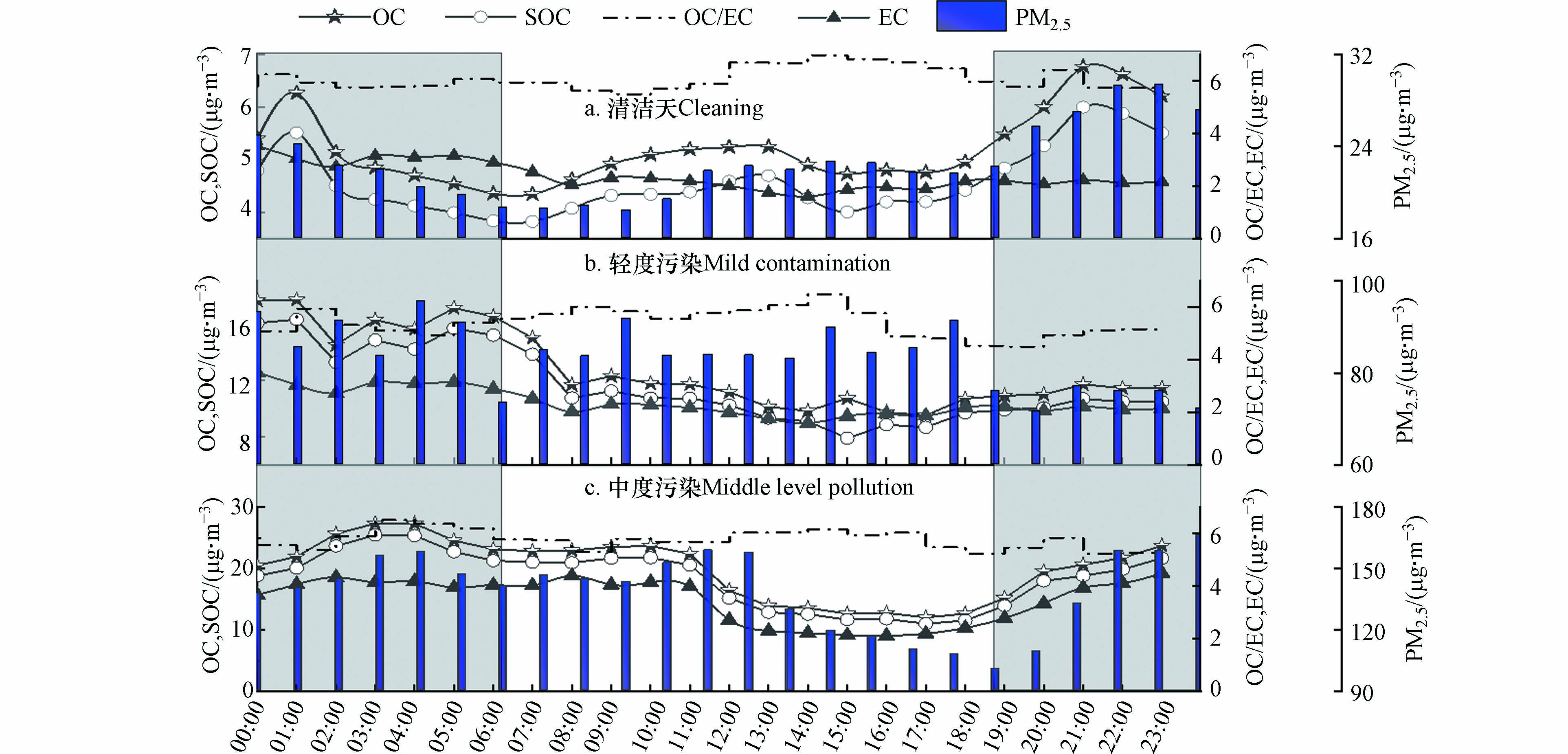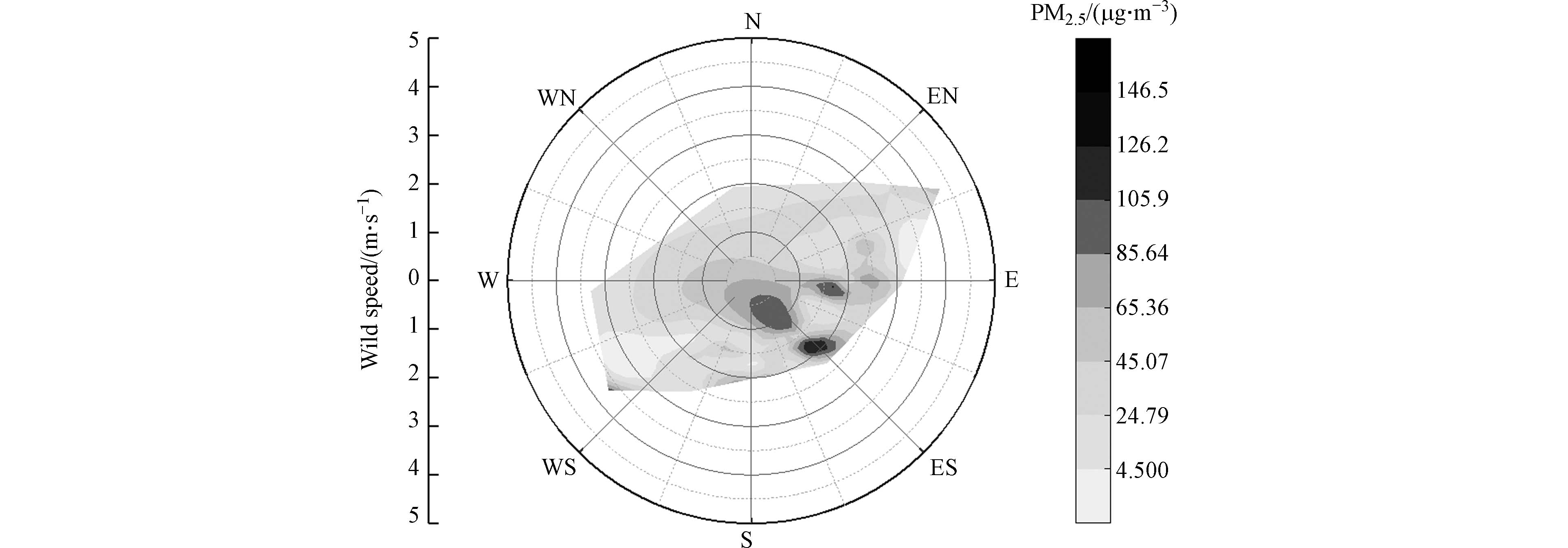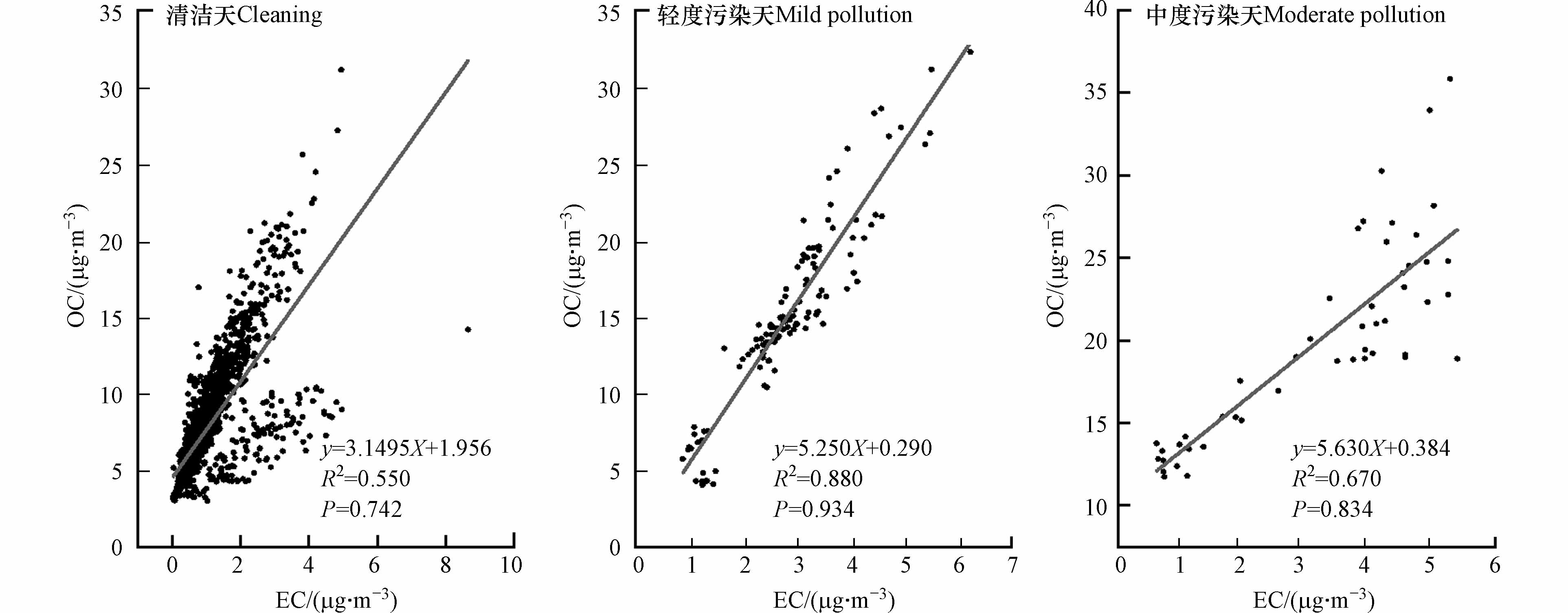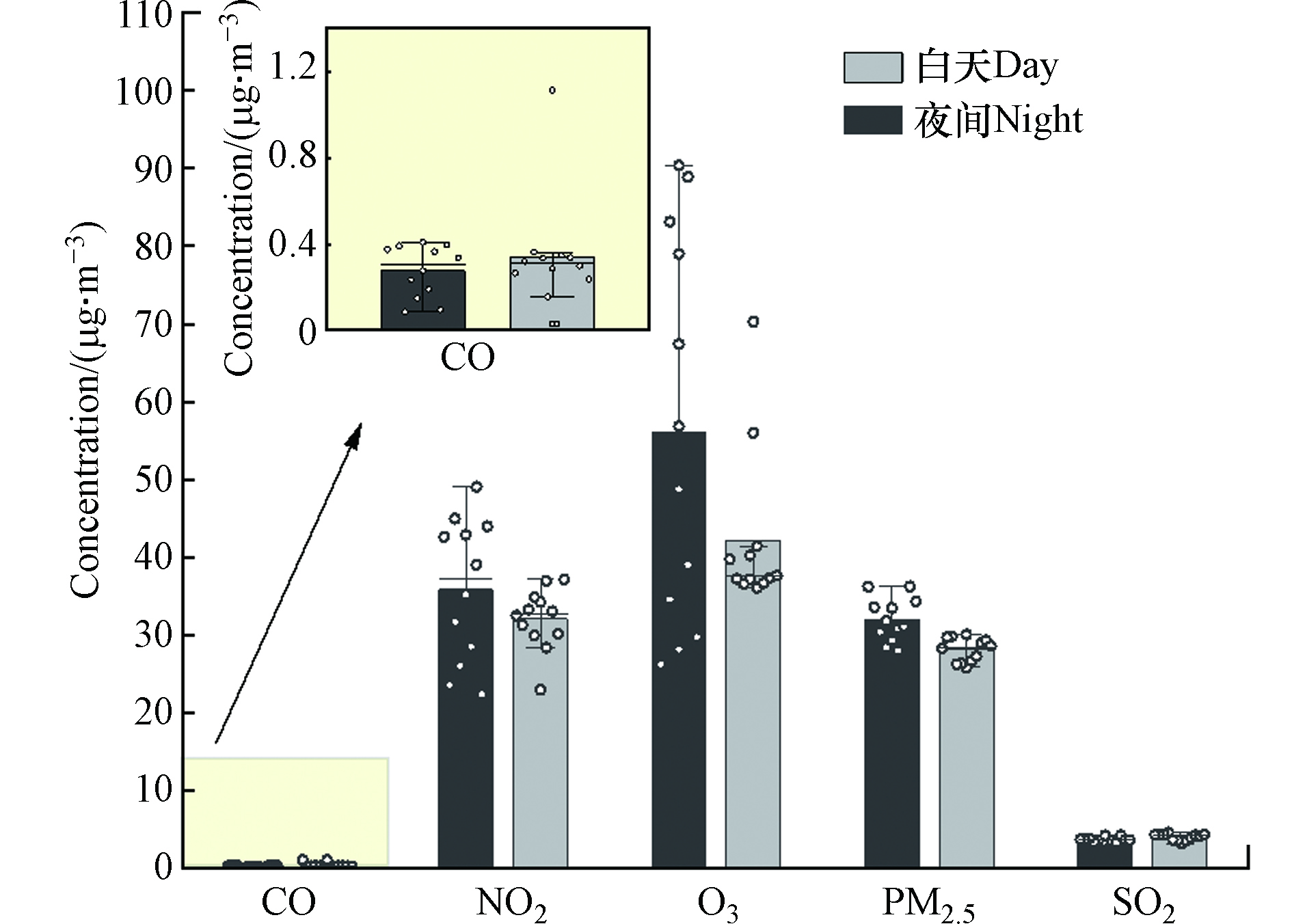-
PM2.5虽然在地球大气成分中的含量较少,但由于其粒径小,富含大量有毒有害物质[1],且在大气中停留时间长,扩散距离远等特征对大气环境[2]、空气质量和人体健康产生等重要影响. PM2.5包含的碳质气溶胶主要有有机碳(OC)和元素碳(EC),OC分为由污染物燃烧直接排放产生的一次有机碳(POC)和污染物经光化学反应后产生的二次有机碳(SOC)[3- 4]. EC主要由化石燃料和生物质燃烧的不完全燃烧产生[5],如机动车尾气、燃煤采暖等[6]. 有研究表明大气颗粒物污染的粒径已开始由粗向细转变,PM2.5的含碳物质甚至超过同一条件下的PM10中的含量. 因此研究细粒径PM2.5中碳质气溶胶污染对现阶段区域或城市大气污染防治更有意义. 目前已有学者对我国各个地区的城市大气碳质气溶胶进行研究,张毓秀[7]、丁峰[8]和程渊等[9]分别对沈阳、北京、天津等北方城市进行了PM2.5中碳质组的污染时空特征、污染来源以及相关性等研究,张菊[10]和黄众思等[11]也对成都、上海等南方城市进行了相关研究,发现PM2.5和碳质气溶胶污染具有冬>春>秋>夏,夜间间>白天的特征;武高峰等[12]对2017年石家庄市采暖季中的PM2.5碳组分进行白天夜间区分研究,发现SOC、SOC/OC值在夜间高于白天;DAO等[13]指出我国北方26个城市PM2.5大气有机和元素碳显著降低. 崔倩等[14]指出从空间分布看,我国北方城市PM2.5平均浓度整体高于南方城市,且浓度水平差距显著,北方城市PM2.5浓度大多在100 μg·m−3上下,南方城市浓度多低于100 μg·m−3;张礁石等[15]对APEC会议前后北京地区污染物分布及变化特征、气象影响因素和气团传输路径特征进行了分析,发现减排措施和有利的气象条件能有效削减污染物排放;Yao等[16]利用DSL监控站点的在线监测数据,研究了的2015—2017年的上海冬季郊区碳质气溶胶的时间演变、气象效应以及主要来源,发现汽车尾气是OC和EC的主要来源,说明在大都市内控制车辆尾气排放是减少碳质气溶胶污染的重要途径. 吴瑕等[17]利用分子标记物、特征比值及主成分分析以及多元线性回归(PCA-MRL)模型等方法探讨了长春有机气溶胶的主要来源.
西安位于关中平原中部,南边秦岭,西安城区位于渭河平原二级阶梯上,近年经济发展较快,人口增长较多,再加上交通区位等条件已使其成为我国重要的战略城市,地形条件和社会发展使得该地区污染源潜在因子较多且污染物易堆积. 本文基于前人研究对2021年秋季PM2.5中的碳质气溶胶进行污染特征和来源探讨,为西安乃至陕西的大气污染防治工作提供借鉴依据.
-
采样点位于西安世博园(109.06°E,34.32°N)内的灞桥区东三环辅路附近平地上的活动板房上,采样口距地面4 m. 使用PM2.5自动分析仪(河北先河环保科技股份有限公司,XHPM2000E)在线监测PM2.5质量浓度,观测时间为2021年秋季(9月1日至11月14日). 该采样点西南靠近灞河,东北毗邻锦绣湖,南面和东面均有学校、商业区、居民住宅区、主要交通线分布,可能涉及的污染源有汽车尾气排放、燃煤等,能够较全面地反应自然和人为活动对大气环境的影响.
本研究采用美国Sunset Model 4/OCEC(RT-4) Lab 有机碳元素碳在线分析仪在线监测PM2.5中的碳质组分,并进行分析,该仪器采用NOSIH认定的热学/光学方法测定石英滤膜上样品所负载的OC和EC,测量范围为0.2—200 μg·m−3,最低检测限(按1 h计)OC为0.4 μg·m−3, EC为0.2 μg·m−3,并用TOT(热光透射法)进行校正. 仪器测定碳质气溶胶需要进行两个阶段加热,炉温均为850 ℃. 第一阶段加热炉温,OC会被挥发或碳化;第二阶段加热过程中氧化环境下EC被分解为气态氧化物. 两次过程中热托有机物和碳化物会随He进入MNO2氧化炉,转化的CO2通过非扩散红外(NDIR)探测系统测定. 由于有机碳OC在第一升温阶段会发生碳化,造成OC测量值偏低和EC测量值偏高,需进行如下校正:在假设颗粒状态的EC和热分解形成的EC具有相同吸收系数的情况下,仪器记录激光光束的透过率并利用NDIR数据和激光吸光率曲线来修正,第一阶段升温过程中的激光透过率等于最初的激光透过率时产生分割点,在这个点之前测得的EC都是由OC经过热分解碳化形成,这部分EC将从第二升温阶段中测得的EC中除去.
利用PM2.5自动分析仪(河北,先河)实时采集PM2.5,SO2、NO2、CO和O3等气体数据取自同期西安广运潭国控站点数据,西安世博园站点和西安广运潭国控站点直线距离为5 km,将两站的的PM2.5进行相关性分析得出其相关系数为0.89,相关性显著,说明PM2.5来源相似. FWS500气象分析仪(北京,富奥通)实时采集气象数据:温度T(°C)、风速WS(m·s−1)和风向WD(°)、气压P(Pa)、相对湿度RH(%)和AGHJ-I-LIDAR激光雷达(中科光电): 边界层高度H(m),降雨量PR(mm)来源于中国气象局天气预报网站https://weather.cma.cn/. 数据时间分辨率均为1 h,每个月仪器均定时校正.
-
由图1可知,西安秋季PM2.5质量浓度均值为(29.6±28.1)μg·m−3,未超过《环境空气质量标准》(GB3095—2012)二级标准限制,日平均浓度最大值为146.1 μg·m−3,最小值为4.6 μg·m−3;总碳TC平均质量浓度为7.2 μg·m−3,其中OC和EC各占84%、15%. OC和EC浓度范围分别为0.6—21.9 μg·m−3、0.1—3.5 μg·m−3,平均质量浓度分别为(6.1±4.3)μg·m−3和(1.2±0.9)μg·m−3,OC、EC对PM2.5的贡献率分别为20.6%和4.0%,西安秋季PM2.5中的碳质气溶胶中OC的变化范围、平均质量浓度和贡献率均大于EC.
图2反映了PM2.5颗粒物及其碳质组分在不同污染天气的白天夜间质量浓度变化特征. 根据《环境空气质量标准》(GB3095—2012),将研究时段中的11月4日(132.1 μg·m−3)和11月5日(146.1 μg·m−3)为中污染天气,平均质量浓度为139.1 μg·m−3;10月3日(75.0 μg·m−3),10月24日(75.2 μg·m−3),10月25日(90.4 μg·m−3),11月1日(77.0 μg·m−3),11月6日(101.5 μg·m−3)等5 d为轻度污染天,平均质量浓度为83.8 μg·m−3,其余均为清洁天,平均质量浓度为22.6 μg·m−3. 中度污染天、轻度污染天和清洁天的OC、EC平均值分别为(20.1±2.6)μg·m−3和(3.5±0.0)μg·m−3、(12.7±2.2)μg·m−3和(2.4±0.4)μg·m−3、(5.2±3.1) μg·m−3和(1.0±0.7) μg·m−3;不同污染天气OC和EC对PM2.5的贡献率分别为14.3%和2.4%、15.1%和2.7%、22.6%和4.4%. 中污染天OC和EC的平均浓度白天为(17.5±5.1)μg·m−3、(3.0±1.0)μg·m−3,夜间为(22.6±3.5)μg·m−3、(4.0±0.5)μg·m−3;轻度污染天OC和EC的平均浓度白天为(11.2±1.5)μg.m−3、(2.0±0.3)μg.m−3,夜间为(14.3±2.8)μg·m−3、(2.7±0.5)μg·m−3;清洁天OC和EC的平均浓度白天为(4.9±0.3)μg·m−3、(0.9±0.1)μg·m−3,夜间为(5.5±0.8)μg·m−3、(1.1±0.2)μg·m−3.
不同污染程度下PM2.5及其碳质组成分的日变化特征基本一致,特征为白天低夜间高,任意小时点污染特征都为污染天>清洁天,且清洁天变化幅度小于污染天. OC出现两个峰值分别在13:00和00:00. 这可能是由于中午太阳辐射较强,大气气流垂直运动较为强烈,上层大气的OC通过垂直运输被带到近地面[18],从而引起午后的OC浓度值升高;凌晨时段气温和边界层高度降低,晚高峰污染产生的二次污染具有滞后性,夜晚大气扩散条件较弱[19-22],夜间间大型货车的尾气排放等多种原因促使氮氧化物加速二次有机碳的转化,因此第二次高峰的OC堆积量较多且浓度值是第一个峰值的0.8倍. EC的两个峰值出现在10:00和21:00—22:00的晚间,两者均出现在早晚高峰之后,说明出行高峰所产生的污染经一段时间的光化学反应后形成二次污染,夜间晚大气结构更为稳定,污染物更易堆积,造成EC质量浓度的第二峰值高于第一峰值. 14:00—15:00较好的大气扩散条件使得EC此时的浓度值偏低,说明EC受到的外来传输的影响较小.
表1统计了国内主要城市秋季PM2.5颗粒物中的OC和EC质量水平. 本研究西安的OCEC浓度低于相近年份的南京[23]、杭州[24]、天津[25]和北京[26]等城市,特别是与人口和工业较密集的天津、北京相比差距更大. 本研究西安OC和EC浓度与前期西安[27]已有的同时段研究相比有所下降,这可能与近年来西安的煤改电政策、减排政策及观测期间降雨有关.
-
由图3可知,9月到11月的PM2.5质量浓度分别为14.0、35.8、52.8 μg·m−3,相对湿度分别为80.3%、79.5%、59.2%,边界层高度分别为781.0 、705.1、602.5 m,均呈下降趋势;采样期间的平均温度为8.5 ℃,最高温度为27.1 ℃,最低为3.0 ℃;相对湿度平均为76.9%,范围在36.3%—97.6%;过去24 h降水量平均为1.6 mm,最大为25.1 mm,降水天数为37 d,降水主要集中在10月;风速风向均采用10 min平均值,风向主要为东南风,风速最大为4.3 m·s−1,无大风天气. 轻度污染天和中污染天内基本无降水,风速分别为1.7 m·s−1和1.8 m·s−1,相对湿度平均为79.0%和78.5%;清洁天降水率为50.0%,平均风速为2.0 m·s−1,相对湿度平均为77.4%. 由此可见知,2021年秋季西安市PM2.5浓度随温度和边界层高度呈反比,相对湿度较高、低风多雨的天气使颗粒污染物不易生产和积累,而偶尔的低风无降水且相对湿度较低的天气会降低污染物的扩散能力[31],从而促使PM2.5的质量浓度上升.
由图4可知,西安市观测期间污染物主要集中在东南部,与主导风向东南风一致. 西安市位于关中平原中和渭河南部,南边秦岭,西南端太白山,地形由南向北倾斜,东边的山间河谷形成一个通风口,使得污染物由东南风传输带来并随地势的逐渐平坦而形成堆积.
-
有研究指出,降水对大气污染物有一定清除作用,但不同的降水强度和污染物浓度会影响清除作用的大小,在降水量小污染浓度大的情况下PM2.5还会出现湿增长的情况[32]. 降水对PM2.5的清除效果可利用清除率来定量分析[33-35],降水后PM2.5浓度的变化率即为清除率(SR,%),其计算公式为:
式中,Ct为降水当天的颗粒物日均浓度,C0为降水前一天的颗粒物日均浓度. SR>0时,为正清除作用;SR<0时,为负清除作用;SR=0时,清除作用为零. 正清除作用数量与清除作用总量之比为正清除率.
研究期间西安市无降水天为39 d,降水天为37 d,按照中国气象局对降水量的划分标准,其中小雨(<10 mm·d−1)34 d,中雨(10—25 mm·d−1)2 d,大雨(25—50 mm·d−1)1 d,降水率为48.7%. 降水天的PM2.5平均浓度为21.4 μg·m−3,无降水天PM2.5平均浓度为37.4 μg·m−3,无降水天比降水天PM2.5浓度增长了74.7%.
表2中,降水量大于25 mm时,PM2.5、OC、EC的正清除率均为100%,此时,随着降水强度的增大正清除率不断提高;当降水量在10—25 mm范围内时,雨水对OC和EC的清除率最大,分别为26.4%和56.7%,正清除率分别为100%和50%,此时OC和EC的平均浓度分别为2.2 μg·m−3和0.4 μg·m−3;降水量在5—10 mm范围内时,雨水对PM2.5和OC、EC碳质气溶胶的清除率有所减小;降水量在0—5 mm范围内时,PM2.5和OCEC碳质气溶胶的清除率都小于0. 说明随着降雨量的增大,雨水对PM2.5及其碳质气溶胶的清除作用会增强,从而降低污染物浓度.
有研究[32]指出降水对大气污染物有一定清除作用,但不同的降水强度和污染物浓度会影响清除作用的大小,在降水量小污染浓度大的情况下还会出现污染物湿增长的情况. 如图5中,日降水量小于10.3 mm,雨前OC质量浓度在3.2—7.8 μg·m−3区间内,降水对OC的平均清除率为-86.8%;降水在4—10 mm范围,EC浓度在0.5—1.7 μg·m−3区间内,清除率为−72.1%;雨前PM2.5在18.7—139.7 μg·m−3的区间内的平均清除率为−66.8%,PM2.5浓度为123.1 μg·m−3,是不同降水程度中的最高值,清除率为−3.5%. 说明降水强度小且污染物浓度较高时,清除率小于0的概率较大,降水的正清除作用较弱. 这是由于在高湿度低降水的情况下颗粒物吸湿表面易膨胀并发生和碰,气态污染物二次转化为颗粒物,从而使颗粒物发生湿增长.
-
EC来自含碳燃料的不充分燃烧,OC的来源有污染物的一次有机碳(POC)和污染物排放后产生光化学作用后形成的二次有机碳(SOC)[13],OC/EC比值法可用于区分碳质气溶胶的排放来源以及鉴别大气中的二次有机碳(SOC)污染. 由于EC的化学性质较稳定,其主要由污染物的一次排放产生,因此可作为直接排放产生的POC的示踪剂. 将OC/EC的平均值与EC关联便可得出一次有机碳中的燃烧源直接排放贡献部分,由此可估算出SOC浓度,(OC/EC)pri_h是连续变化的假想值,通过((OC/EC)pri_h算出对应的假想SOCh,和EC对的SOCh相关系系数(R2)[36-37]. 如果EC和SOCh的变化是独立的(即不相关),假设(OC/EC)pri_h对应于最小R2(EC,SOCh)的位置所得到的OC/EC比值即认为是MRS得出的一次比值,(OC/EC)pri_MRS. SOC的估算公式为:
式中,TOC为OC总量;
$ {\left(\mathrm{O}\mathrm{C}/\mathrm{E}\mathrm{C}\right)}_{\mathrm{p}\mathrm{r}\mathrm{i}} $ 代表一次燃烧源排放的OC/EC的比值,(OC/EC)pri_h在MRS中的扫描范围为0—10. 已有研究指出,OC/EC>2时大气污染中存在SOC,比值越大SOC含量越多,且不同OC/EC的比值范围代表不同的污染来源[38]:机动车排放源的OC/EC比值为2.5—5.0;工业排放源中的OC/EC比值为3.5—5.5;燃煤和生物质燃烧的OC/EC比值分别为8.1—12.7和2.5—10.5[39]. 图6中,MRS模型拟结果显示西安市OC/EC比值在研究期间的平均值为3.15,污染源主要来自机动车排放、生物质燃烧.计算得出SOC和POC的平均值分别为4.3 μg·m−3和1.7 μg·m−3,对OC的贡献率分别为71.7%和28.3%,9—11月SOC浓度平均值分别为1.0、0.7、2.8 μg·m−3,3个月SOC在OC中的占比分别为80.0%、75.1%和54.4%,说明随着污染的加重,有机碳生成过程中的二次反应也增多.
-
OC,EC之间的相关性显著程度可以反映两者来源的同源性,相关系数越高说明同源性越高[27]. 对OC和EC质量浓度进行线性拟合回归分析[40-41]可得出反映OC来源的回归方程: OC=EC×a+b, EC×a表示OC中的燃烧直接排放部分,b为OC中非燃烧直接排放部分.
图7可知,清洁天中OC和EC的相关性(R2<0.6, P<0.0001)不明显, R2值为0.550;污染天中OC与EC具有一定的相关性(R2>0.6, P<0.0001), 轻度污染天的相关性(R2=0.880)较高,中度污染天气(R2=0.670)相关性较低,说明不同污染程度下OC和EC的来源复杂程度为清洁天>中度污染天气>轻度污染天;EC×a项表现为污染天>清洁天,b项表现为清洁天>污染天。从排放源来看,不同污染程度下均是燃烧直接排放大于非燃烧排放,说明研究区的OC来源以燃烧直接排放为主.
有研究指出,燃煤可导致SO2浓度升高,NO2和CO主要受机动车尾气排放影响. 利用SPSS软件计算碳质气溶胶与其他污染气体的相关性可探究SOC的转化来源.
图8显示西安市污染气体主要是NO2和CO;表3显示了碳质气溶胶与SO2、NO2和CO污染气体的相关性. NO2与碳质气溶胶都呈显著相关,CO、O3与碳质气溶胶相关性不显著,SOC与NO2、SO2的相关性显著,说明机动车排放和燃煤活动对二次有机碳的影响较大. 根据陕西省2020年统计年鉴的数据,西安市大气中2020年的SO2排放量相比于2019年下降了17.7%,其中工业SO2排放量下降了40.7%,而氮氧化物排放量上升了84.9%,且其排放总量是SO2排放量的1.7倍,这可能与西安市的能源结构调整和污染治理措施有关. 西安市化石燃料产生的SO2污染排放减少,碳质污染物主要来自机动车尾气排放,在污染物排放过程中一次有机碳(POC)和其他碳质组分与SO2、NO2和CO等气体产生光化学反应,促使二次有机碳(SOC)的生成.
-
(1) 西安市秋季PM2.5、OC、EC平均浓度分别为(29.6±28.1)μg·m−3、(6.1±4.3)μg·m−3和(1.2±0.9)μg·m−3;OC、EC浓度质量日变化都呈白天低夜间晚高的特征;中污染天、轻度污染天和清洁天的OC、EC平均值分别为(20.1±2.6)μg·m−3和(3.5±0.0)μg·m−3、(12.7±2.2)μg·m−3和(2.4±0.4)μg·m−3、(5.2±3.1)μg·m−3和(1.0±0.7)μg·m−3;不同污染天气OC和EC对PM2.5的贡献率分别为14.3%和2.4%、15.1%和2.7%、22.6%和4.4%,小时平均浓度污染特征都为污染天>清洁天.
(2) 随着降雨量的增大,PM2.5及其碳质气溶胶的浓度值在降低,但清除率受到降水强度的颗粒物浓度的综合影响. 降水强度小但PM2.5及其碳质气溶胶浓度较高,或强度较大但颗粒物浓度低,降水的正清除作用较弱.
(3) 研究期间,西安市OC/EC比值的平均值为3.15,说明大气中存在着较为明显的二次有机碳污染;不同污染程度下OC,EC的来源复杂程度清洁天<轻度污染天<中度污染天气,从排放源来看不同污染程度下均是燃烧直接排放大于非燃烧排放.
(4) SOC的平均值为4.3 μg·m−3,对OC的贡献率为71.7%,白天夜间SOC浓度平均值为5.8 μg·m−3和4.5 μg·m−3,从而使有机碳的二次污染转化较为明显;SOC与NO2和SO2的相关性显著,说明研究期间西安有机碳的二次污染转化较为明显且主要来源为机动车尾气、生物质燃烧.
西安市秋季PM2.5中碳质组分特征及来源分析
Distribution characteristics and source analysis of carbonaceous PM2.5 in autumn in Xi’an
-
摘要: 本文基于西安市2021年9月1日至11月14日利用Sunset Model 4/OCEC(RT-4) Lab 有机碳元素碳在线分析仪实时采集PM2.5中的OC和EC,分析了PM2.5、OC和EC的质量浓度特征,结合湿清除率探究降水强度与PM2.5的关系,利用OC/EC比值、OC与EC相关性以及二次有机碳(SOC)估算探究OC和EC的排放来源. 结果表明,西安市秋季PM2.5、OC和EC平均浓度分别为(29.6±28.1)μg·m−3、(6.1±4.3)μg·m−3、(1.2±0.9)μg·m−3;OC和EC浓度质量变化都呈夜间高于白天和中度污染>轻度污染>清洁天的特征. 污染物清除率受到降水强度和污染物浓度的综合影响. 降水强度小但PM2.5及其碳质气溶胶浓度较高的情况下,降水的正清除作用较弱. 西安市OC/EC比值的平均值为3.15,说明大气中存在着较为明显的二次有机碳污染;不同污染程度下OC,EC的来源复杂程度为清洁天>中度污染天气>轻度污染天,从排放源来看,不同污染程度下均是燃烧直接排放大于非燃烧排放. SOC的平均值为4.3 μg·m−3,对OC的贡献率为71.7%,SOC与NO2、SO2的相关性显著,说明研究期间西安有机碳的二次污染转化较为明显且主要来源于机动车尾气,生物质燃烧和工业排放.Abstract: In this paper, Sunset Model 4/OCEC(RT-4)Lab Organic Carbon online analyzer was used to determine OC and EC in PM2.5 from September 1 to November 14, 2021 in Xi'an in real time. The mass concentration characteristics of PM2.5, OC and EC were analyzed, and the relationship between precipitation intensity and PM2.5 was explored based on the wet clearance rate. The emission sources of OC and EC were estimated by the ratio of OC/EC, correlation between OC and EC, and secondary organic carbon (SOC). The results showed that: (1) the average concentrations of PM2.5, OC and EC in Xi'an in autumn were (29.6 ± 28.1) μg·m−3, (6.1 ± 4.3) μg·m−3 and (1.2 ± 0.9) μg·m−3, respectively. OC and EC concentrations at night were significantly higher than those at day, and presented a trend of moderate pollution > light pollution > clean days. (2) The pollutant removal rate is influenced by precipitation intensity and pollutant concentration. When the precipitation intensity is small but PM2.5 and its carbon aerosol concentration is high, or when precipitation intensity is large but PM2.5 concentration is low, the positive clearance effect of precipitation is weak. (3) The average value of OC/EC ratio in Xi’an is 3.15, indicating the obvious secondary organic carbon pollution in the atmosphere. The trend of source complexity of OC and EC was clean > moderate pollution > light pollution days. Direct combustion emissions were greater than non-combustion emissions under different pollution levels. (4) The mean value of SOC was 4.3 μg·m−3, and the contribution rate to OC was 71.7%. The correlation between SOC and NO2 and SO2 was significant, indicating that the secondary pollution transformation of organic carbon in Xi'an was obvious and mainly came from vehicle exhaust, biomass burning and industrial emissions during the study period.
-
Key words:
- organic carbon /
- carbon element /
- PM2.5 /
- SOC estimation /
- rainwater removal /
- Xi’an.
-

-
表 1 国内城市PM2.5中OC、EC浓度和OC/EC水平
Table 1. OC and EC concentrations and OC/EC levels in PM2. 5in Domestic cities
采样点
Sampling site采样时间
Sampling timeOC/(μg·m−3) EC/(μg·m−3) OC/EC 测量方法
Measuring method数据来源
Data sources西安 2021秋 6.1±4.3 1.2±0.9 1.4±1.1 TOT 本文 西安 2017秋 10.74±4.12 2.34±0.92 4.6±1.32 TOT [27] 北京 2016秋 17.5 2.3 7.6 TOR [26] 天津 2020冬 15.63 4.19 3.73 TOT [25] 成都 2017秋 9.25±3.8 4.27±1.7 2.18±0.41 TOT [10] 南京 2018秋 6.16±3.07 2.48±1.42 2.32±2.06 TOT [23] 南昌 2013秋 11.03 4.46 2.5 TOT [28] 杭州 2019秋 10.0 2.4 4.2 TOR [24] 广州 2015秋 5.86±2.16 1.40±0.56 4.18±1.25 TOR [29] 上海 2010夏 8.6±6.2 2.4±1.3 3.80±1.59 TOR [30] 表 2 降水量与PM2.5、OC、EC的清除关系
Table 2. Clearance relationship between precipitation and PM2.5, OC, EC
PM2.5/(μg·m−3) 降水量/mm
Precipitation清除率/%
Clearance ratio正清除率/%
Positive clearance ratio23.1 0—5 -3.5 60.0 14.8 5—10 28.4 75.0 12.2 10—25 12.1 50.0 11.4 >25 6.4 100.0 OC/(μg·m−3) 降水量/mm
Precipitation清除率/%
Clearanceratio正清除率/%
Positive clearance ratio4.4 0—5 -40.8 39.2 3.0 5—10 3.3 50.0 2.2 10—25 26.4 100.0 2.6 >25 15.7 100.0 EC/(μg·m−3) 降水量/mm
Precipitation清除率/%
Clearanceratio正清除率/%
Positive clearance ratio0.9 0—5 -46.4 25.0 0.6 5—10 3.1 50.0 0.4 10—25 56.7 50.0 0.4 >25 7.9 100.0 表 3 碳质组分与SO2、NO2、CO、O3相关性
Table 3. Correlation between carbon components and SO2, NO2, CO, O3
OC EC SOC SO2 NO2 CO O3 PM2.5 OC 1 0.7067 0.8545** 0.2872 0.7005** 0.0946 0.1211 0.6821** EC 1 0.2456 0.2456 0.5562** -0.0364 -0.1051 0.7752** SOC 1 0.4964* 0.5288** 0.1475 0.1030 0.3493 SO2 1 0.2196 0.4923* 0.7715** -0.1046 NO2 1 0.5394** 0.0330 0.5259** CO 1 0.40276 0.1525 O3 -0.1051 PM2.5 1 **P<0.01, *P<0.05. -
[1] 严梦园, 程燕, 田杰, 等. 西安城区冬季污染天单颗粒气溶胶的化学组分特征及混合状态 [J]. 环境化学, 2022, 41(3): 823-833. YAN M Y, CHENG Y, TIAN J, et al. Chemical composition and Mixing states of single atmospheric particles in Xi'an during winter [J]. Environmental Chemistry, 2022, 41(3): 823-833(in Chinese).
[2] CHOWDHURY S, POZZER A, HAINES A, et al. Global health burden of ambient PM2.5 and the contribution of anthropogenic black carbon and organic aerosols [J]. Environment International, 2022, 159: 107020. doi: 10.1016/j.envint.2021.107020 [3] 孙玺, 周声圳, 高敏, 等. 珠海2019年秋季一次大气污染过程的特征、成因及来源分析 [J]. 环境科学学报, 2022, 42(8): 64-75. SUN X, ZHOU S C, GAO M, et al. Analysis of the characteristics, formation mechanisms and sources of an atmospheric pollution in Zhuhai during the autumn of 2019 [J]. Acta Scientiae Circumstantiae, 2022, 42(8): 64-75(in Chinese).
[4] 李婧琳, 曾友石, 刘卫, 等. 拉萨市大气中碳颗粒物的浓度变化及特征 [J]. 环境化学, 2020, 39(4): 911-919. doi: 10.7524/j.issn.0254-6108.2019092205 LI J L, ZENG Y S, LIU W, et al. Concentration changes and characteristics of atmospheric carbon particulates in Lhasa [J]. Environmental Chemistry, 2020, 39(4): 911-919(in Chinese). doi: 10.7524/j.issn.0254-6108.2019092205
[5] WANG H B, ZHANG L M, YAO X H, et al. Identification of decadal trends and associated causes for organic and elemental carbon in PM2.5 at Canadian urban sites [J]. Environment International, 2022, 159: 107031. doi: 10.1016/j.envint.2021.107031 [6] XIE M J, PENG X, SHANG Y, et al. Collocated measurements of light-absorbing organic carbon in PM2.5: Observation uncertainty and organic tracer-based source apportionment [J]. Journal of Geophysical Research:Atmospheres, 2022, 127(5): e2021JD035874. [7] 张毓秀, 任万辉, 王嘉禾, 等. 沈阳市冬季不同污染程度PM2.5中OC和EC污染特征 [J]. 中国环境科学, 2021, 41(7): 3066-3075. doi: 10.3969/j.issn.1000-6923.2021.07.008 ZHANG Y X, REN W H, WANG J H, et al. Characteristics of organic carbon(OC) and elemental carbon(EC) under different pollution levels of PM2.5 during winter in Shenyang [J]. China Environmental Science, 2021, 41(7): 3066-3075(in Chinese). doi: 10.3969/j.issn.1000-6923.2021.07.008
[8] 丁峰, 朱志锋, 陆晓波, 等. 2014—2018年南京PM2.5中碳组分污染特征分析 [J]. 中国环境监测, 2020, 36(2): 165-172. DING F, ZHU Z F, LU X B, et al. Characteristics analysis of carbon components in PM2.5 in Nanjing from 2014 to 2018 [J]. Environmental Monitoring in China, 2020, 36(2): 165-172(in Chinese).
[9] 程渊, 刘保双, 毕晓辉, 等. 天津市区夏冬季环境空气PM2.5中碳组分污染特征及来源研究 [J]. 环境科学学报, 2018, 38(9): 3394-3405. CHENG Y, LIU B S, BI X H, et al. Character and source analysis of carbonaceous aerosol in PM2.5 during summer-winter period, Tianjin urban area [J]. Acta Scientiae Circumstantiae, 2018, 38(9): 3394-3405(in Chinese).
[10] 张菊, 林瑜, 乔玉红, 等. 成都市西南郊区夏秋季PM2.5碳组分化学特征 [J]. 环境工程, 2017, 35(10): 100-104. ZHANG J, LIN Y, QIAO Y H, et al. Character of carbonaceous aerosol in pm2.5 during summer-autumn period in southwest suburb of Chengdu [J]. Environmental Engineering, 2017, 35(10): 100-104(in Chinese).
[11] 黄众思, 修光利, 朱梦雅, 等. 上海市夏冬两季PM2.5中碳组分污染特征及来源解析 [J]. 环境科学与技术, 2014, 37(4): 124-129. HUANG Z S, XIU G L, ZHU M Y, et al. Characteristics and sources of carbonaceous species in PM2.5 in summer and winter in Shanghai [J]. Environmental Science & Technology, 2014, 37(4): 124-129(in Chinese).
[12] 武高峰, 王丽丽, 武志宏, 等. 石家庄市采暖季PM2.5碳组分昼夜污染特征及来源分析 [J]. 环境科学学报, 2020, 40(7): 2356-2364. WU G F, WANG L L, WU Z H, et al. Pollution diurnal variation and source analysis of PM2.5 carbon components in heating season in Shijiazhuang City [J]. Acta Scientiae Circumstantiae, 2020, 40(7): 2356-2364(in Chinese).
[13] DAO X, JI D S, ZHANG X, et al. Significant reduction in atmospheric organic and elemental carbon in PM2.5 in 2+26 cities in Northern China [J]. Environmental Research, 2022, 211: 113055. doi: 10.1016/j.envres.2022.113055 [14] 崔倩, 张艳平, 莫杨, 等. 我国主要城市大气颗粒物及碳组分污染水平研究进展 [J]. 环境卫生学杂志, 2021, 11(3): 287-295. doi: 10.13421/j.cnki.hjwsxzz.2021.03.012 CUI Q, ZHANG Y P, MO Y, et al. Research advances in atmospheric particulate matter and carbon component pollution levels in major cities of China [J]. Journal of Environmental Hygiene, 2021, 11(3): 287-295(in Chinese). doi: 10.13421/j.cnki.hjwsxzz.2021.03.012
[15] 张礁石, 陆亦怀, 桂华侨, 等. APEC会议前后北京地区PM2.5污染特征及气象影响因素 [J]. 环境科学研究, 2016, 29(5): 646-653. ZHANG J S, LU Y H, GUI H Q, et al. Variations of PM2.5 pollution and related meteorological factors before and after the 2014 APEC conference in Beijing [J]. Research of Environmental Sciences, 2016, 29(5): 646-653(in Chinese).
[16] YAO L, HUO J T, WANG D F, et al. Online measurement of carbonaceous aerosols in suburban Shanghai during winter over a three-year period: Temporal variations, meteorological effects, and sources [J]. Atmospheric Environment, 2020, 226: 117408. doi: 10.1016/j.atmosenv.2020.117408 [17] 吴瑕, 曹芳, 翟晓瑶, 等. 长春秋季细颗粒物中有机气溶胶组成特征及来源 [J]. 环境科学, 2019, 40(8): 3438-3446. doi: 10.13227/j.hjkx.201901031 WU X, CAO F, ZHAI X Y, et al. Molecular composition and source apportionment of fine organic aerosols in autumn in Changchun [J]. Environmental Science, 2019, 40(8): 3438-3446(in Chinese). doi: 10.13227/j.hjkx.201901031
[18] ZHU T, SHANG J, ZHAO D F. The roles of heterogeneous chemical processes in the formation of an air pollution complex and gray haze [J]. Science China Chemistry, 2011, 54(1): 145-153. doi: 10.1007/s11426-010-4181-y [19] MOOIBROEK D, SCHAAP M, WEIJERS E P, et al. Source apportionment and spatial variability of PM2.5 using measurements at five sites in the Netherlands [J]. Atmospheric Environment, 2011, 45(25): 4180-4191. doi: 10.1016/j.atmosenv.2011.05.017 [20] MIN X Y, XU D Y, HU X, et al. Changes in total organic carbon and organic carbon fractions of reclaimed minesoils in response to the filling of different substrates [J]. Journal of Environmental Management, 2022, 312: 114928. doi: 10.1016/j.jenvman.2022.114928 [21] 彭小乐, 郝庆菊, 温天雪, 等. 重庆市北碚城区气溶胶中有机碳和元素碳的污染特征 [J]. 环境科学, 2018, 39(8): 3502-3510. doi: 10.13227/j.hjkx.201711205 PENG X L, HAO Q J, WEN T X, et al. Pollution characteristics of organic carbon and elemental carbon in atmospheric aerosols in Beibei district, Chongqing [J]. Environmental Science, 2018, 39(8): 3502-3510(in Chinese). doi: 10.13227/j.hjkx.201711205
[22] ZHAO L, LUN X X, LI R N, et al. Deposition of PM2.5 sulfate in the spring on urban forests in Beijing, China [J]. Atmosphere, 2017, 8(12): 3. [23] 袁思宇, 沈国锋, 赵秋月. 南京市秋季大气颗粒物中有机碳和元素碳的浓度水平及分布特征 [J]. 环境化学, 2014, 33(5): 724-730. doi: 10.7524/j.issn.0254-6108.2014.05.021 YUAN S Y, SHEN G F, ZHAO Q Y. Concentrations and distribution characteristics of organic carbon and element carbon in ambient particulate matter(PM10 and PM2.5)during autumn in Nanjing [J]. Environmental Chemistry, 2014, 33(5): 724-730(in Chinese). doi: 10.7524/j.issn.0254-6108.2014.05.021
[24] 朱俊, 王琼真, 丁皓, 等. 环杭州湾区域秋冬季PM2.5中有机碳和元素碳污染特征及来源 [J]. 环境污染与防治, 2021, 43(7): 864-870. ZHU J, WANG Q Z, DING H, et al. Characteristics and sources of organic carbon and elemental carbon in PM2.5 in autumn and winter of Hangzhou Bay area [J]. Environmental Pollution & Control, 2021, 43(7): 864-870(in Chinese).
[25] 姜建芳, 侯丽丽, 齐梦溪, 等. 天津市采暖季PM2.5中碳组分污染特征及来源分析 [J]. 生态环境学报, 2020, 29(6): 1181-1188. JIANG J F, HOU L L, QI M X, et al. Pollution characteristics and sources of carbonaceous components in PM2.5 during heating season in Tianjin [J]. Ecology and Environmental Sciences, 2020, 29(6): 1181-1188(in Chinese).
[26] 吕喆, 韩力慧, 程水源, 等. 北京城区冬夏季含碳气溶胶浓度特征及区域传输对灰霾形成影响 [J]. 北京工业大学学报, 2018, 44(3): 463-472. doi: 10.11936/bjutxb2017030027 LYU Z, HAN L H, CHENG S Y, et al. Characteristics of carbonaceous aerosols and influence of regional transport on haze formation in winter and summer in urban of Beijing [J]. Journal of Beijing University of Technology, 2018, 44(3): 463-472(in Chinese). doi: 10.11936/bjutxb2017030027
[27] 康宝荣, 刘立忠, 刘焕武, 等. 关中地区细颗粒物碳组分特征及来源解析 [J]. 环境科学, 2019, 40(8): 3431-3437. doi: 10.13227/j.hjkx.201810189 KANG B R, LIU L Z, LIU H W, et al. Pollution characteristics and sources of carbonaceous components in PM2.5 in the Guanzhong area [J]. Environmental Science, 2019, 40(8): 3431-3437(in Chinese). doi: 10.13227/j.hjkx.201810189
[28] 郑权, 赵莉斯, 于瑞莲, 等. 南昌市秋季大气PM2.5中碳组分污染特征 [J]. 环境科学导刊, 2018, 37(3): 6-10. ZHENG Q, ZHAO L S, YU R L, et al. Characteristics of carbonaceous components in PM2.5 in Nanchang City, China [J]. Environmental Science Survey, 2018, 37(3): 6-10(in Chinese).
[29] 刘晶晶, 胡献舟, 黄凤莲, 等. 广州PM2.5中有机碳和元素碳的污染特征 [J]. 湖南科技大学学报(自然科学版), 2019, 34(4): 111-117. LIU J J, HU X Z, HUANG F L, et al. Characteristics of organic carbon(OC) and elemental carbon(EC) in PM2.5 in Guangzhou, China [J]. Journal of Hunan University of Science & Technology (Natural Science Edition), 2019, 34(4): 111-117(in Chinese).
[30] 张懿华, 王东方, 赵倩彪, 等. 上海城区PM2.5中有机碳和元素碳变化特征及来源分析 [J]. 环境科学, 2014, 35(9): 3263-3270. ZHANG Y H, WANG D F, ZHAO Q B, et al. Characteristics and sources of organic carbon and elemental carbon in PM2.5 in Shanghai urban area [J]. Environmental Science, 2014, 35(9): 3263-3270(in Chinese).
[31] 赵晨曦, 王云琦, 王玉杰, 等. 北京地区冬春PM2.5和PM10污染水平时空分布及其与气象条件的关系 [J]. 环境科学, 2014, 35(2): 418-427. ZHAO C X, WANG Y Q, WANG Y J, et al. Temporal and spatial distribution of PM2.5 and PM10 pollution status and the correlation of particulate matters and meteorological factors during winter and spring in Beijing [J]. Environmental Science, 2014, 35(2): 418-427(in Chinese).
[32] 栾天, 郭学良, 张天航, 等. 不同降水强度对PM2.5的清除作用及影响因素 [J]. 应用气象学报, 2019, 30(3): 279-291. doi: 10.11898/1001-7313.20190303 LUAN T, GUO X L, ZHANG T H, et al. The scavenging process and physical removing mechanism of pollutant aerosols by different precipitation intensities [J]. Journal of Applied Meteorological Science, 2019, 30(3): 279-291(in Chinese). doi: 10.11898/1001-7313.20190303
[33] 于彩霞, 邓学良, 石春娥, 等. 降水和风对大气PM2.5、PM10的清除作用分析 [J]. 环境科学学报, 2018, 38(12): 4620-4629. YU C X, DENG X L, SHI C E, et al. The scavenging effect of precipitation and wind on PM2.5 and PM10 [J]. Acta Scientiae Circumstantiae, 2018, 38(12): 4620-4629(in Chinese).
[34] 何涛, 彭燕, 雷正翠. 常州市颗粒物湿清除和雨后PM2.5浓度增长研究 [J]. 环境污染与防治, 2021, 43(9): 1114-1117,1123. HE T, PENG Y, LEI Z C. Wet scavenging of particulate matter and increase of PM2.5 after rain in Changzhou [J]. Environmental Pollution & Control, 2021, 43(9): 1114-1117,1123(in Chinese).
[35] 周广强, 瞿元昊, 高伟, 等. 云下湿清除作用对长三角PM2.5模拟的影响 [J]. 中国环境科学, 2020, 40(7): 2794-2801. doi: 10.3969/j.issn.1000-6923.2020.07.002 ZHOU G Q, QU Y H, GAO W, et al. Simulated impact of blow-cloud wet scavenging on PM2.5 over the YRD [J]. China Environmental Science, 2020, 40(7): 2794-2801(in Chinese). doi: 10.3969/j.issn.1000-6923.2020.07.002
[36] WU C, YU J Z. Determination of primary combustion source organic carbon-to-elemental carbon (OC / EC) ratio using ambient OC and EC measurements: Secondary OC-EC correlation minimization method [J]. Atmospheric Chemistry and Physics, 2016, 16(8): 5453-5465. doi: 10.5194/acp-16-5453-2016 [37] WU C, WU D, YU J Z. Quantifying black carbon light absorption enhancement with a novel statistical approach [J]. Atmospheric Chemistry and Physics, 2018, 18(1): 289-309. doi: 10.5194/acp-18-289-2018 [38] 李朝阳, 袁亮, 张小玲, 等. 成都碳质气溶胶变化特征及二次有机碳的估算[J]. 中国环境科学, 2022, 42(6): 2504-2513. LI C Y, YUAN L, ZHANG X L, et al. Characteristics of carbonaceous aerosols and estimation of secondary organic carbon in Chengdu [J]. China Environmental Science, 2022, 42(6): 2504-2513(in Chinese).
[39] 谢添, 曹芳, 章炎麟, 等. 2015~2019年南京北郊碳质气溶胶组成变化 [J]. 环境科学, 2022, 43(6): 2858-2866. XIE T, CAO F, ZHANG Y L, et al. Changes of carbonaceous aerosol in the northern suburb of Nanjing from 2015 to 2019 [J]. Environmental Science, 2022, 43(6): 2858-2866(in Chinese).
[40] 杜博涵, 黄晓锋, 何凌燕, 等. 宁波市PM2.5中碳组分的时空分布特征和二次有机碳估算 [J]. 环境科学, 2015, 36(9): 3128-3134. DU B H, HUANG X F, HE L Y, et al. Seasonal and spatial variations of carbon fractions in PM2.5 in Ningbo and the estimation of secondary organic carbon [J]. Environmental Science, 2015, 36(9): 3128-3134(in Chinese).
[41] 薛凡利, 牛红亚, 武振晓, 等. 邯郸市PM2.5和PM10中有机碳与元素碳的污染特征 [J]. 环境化学, 2021, 40(10): 3246-3257. doi: 10.7524/j.issn.0254-6108.2020061701 XUE F L, NIU H Y, WU Z X, et al. Pollution characteristics of organic carbon and elemental carbon in PM2.5 and PM10 of Handan City [J]. Environmental Chemistry, 2021, 40(10): 3246-3257(in Chinese). doi: 10.7524/j.issn.0254-6108.2020061701
-



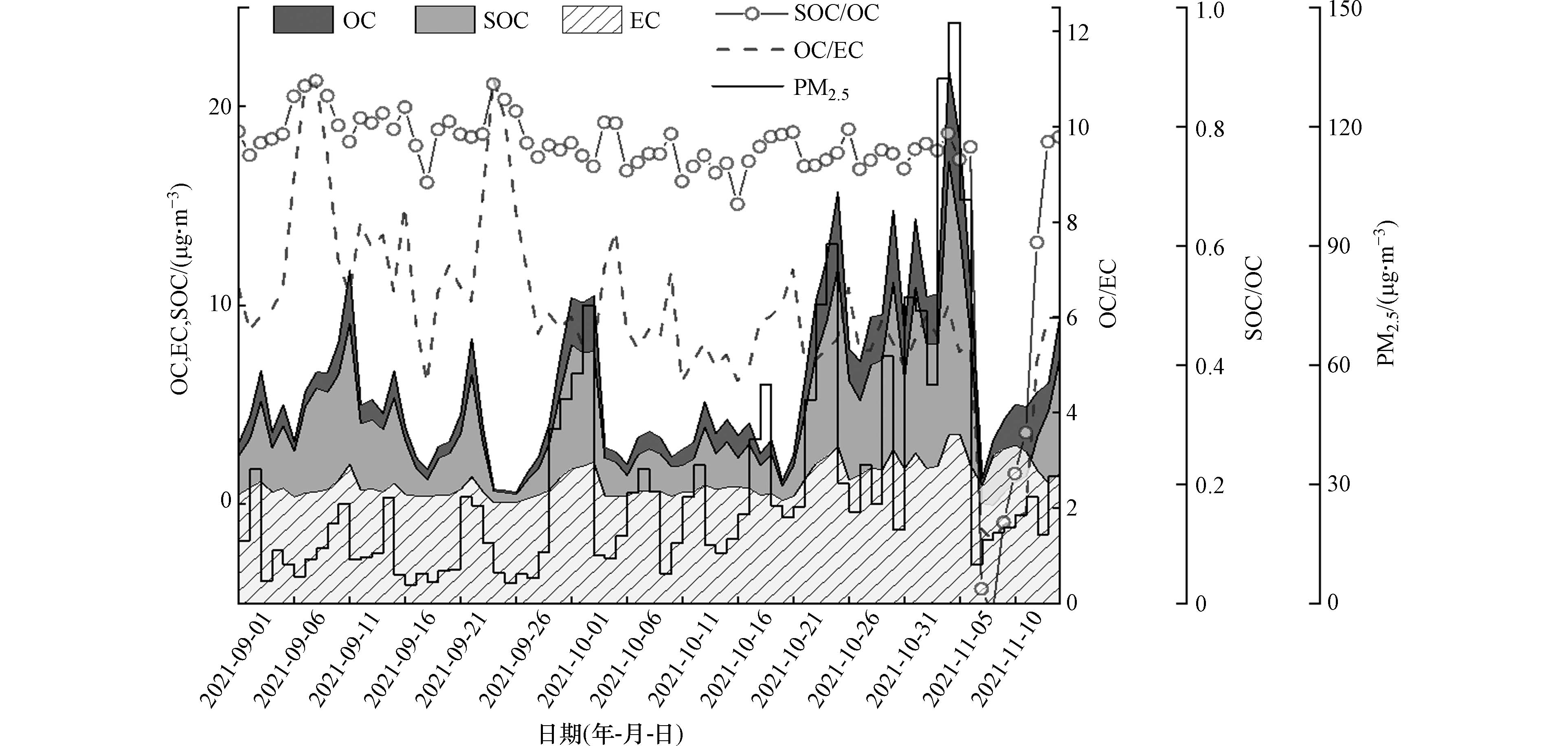
 下载:
下载:
